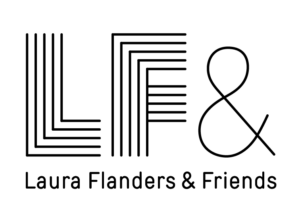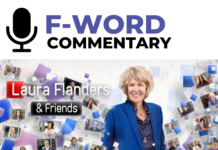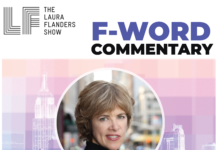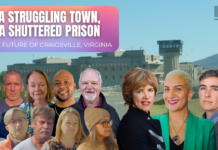Prefer to Listen?
Subscribe to our podcast to listen to this week’s episode on your favorite podcast platform.
Low income Americans face an acute housing shortage. But our guests have a victory to share. “Rabble Rousers: Frances Goldin and the Fight for Cooper Square” is a newly-released documentary telling the story of how a diverse group of New Yorkers, led by housing organizer Frances Goldin, fought a 50-year struggle against abandonment, white flight, violence, drugs and “Power Broker” Robert Moses to save a 12-block section of lower Manhattan from being destroyed. They created the first urban Community Land Trust (CLT), and thousands of homes and businesses were saved from speculation. The CLT established permanent low-income housing for Cooper Square residents. The film, which is out now from New Day Films, was directed and produced by our guests Kelly Anderson and Ryan Joseph, with Kathryn Barnier. Anderson and Joseph, along with historian Johanna Fernández join Laura to discuss the significance of Goldin, rabble rousing and the Cooper Square story for today. Plus, a commentary from Laura on “lost causes” that aren’t.
“The housing situation is only getting worse…We need policy solutions to address problems that were created through racist and classist policies to begin with.” – Kelly Anderson
“What creates is a model for others to follow. And that is the notion that public lands should be connected to the idea of the public good, meaning that they can never be sold at a profit in the future by people who live there.” – Johanna Fernández
“ wanted to make sure that the movement was integrated from the start. And in doing so, she formed coalitions quickly between Blacks, Browns, Jews, Puerto Ricans . . . She was able to take the movement to City Hall because she had people in numbers.” – Ryan Joseph
Guests
- Kelly Anderson: Producer/Director, “Rabble Rousers: Frances Goldin and the Fight for Cooper Square”
- Johanna Fernández: Professor, 20th Century US History & the History of Social Movements at Baruch College & the Graduate Center CUNY
- Ryan Joseph: Producer/Director, “Rabble Rousers: Frances Goldin and the Fight for Cooper Square”
Transcript
THE LAURA FLANDERS SHOW
FRANCES GOLDIN, “RABBLE ROUSERS” & THE NYC HOUSING STRUGGLE THAT WON
LAURA FLANDERS: The bad news just keeps on coming. Low-income Americans face an acute shortage of affordable housing. Some estimate that the nation needs 7 million affordable homes we don’t currently have. But our guests have a success story to tell. In a new film, they track a 50-year fight against staggering odds to save a 12 block stretch of lower Manhattan in New York to save it from abandonment, white flight, violence, drugs, and none other than the power broker developer himself, Robert Moses. Featuring an irrepressible organizer, Frances Goldin, the film traces what the filmmakers call a rabble of regular New Yorkers, people in the neighborhood who saved thousands of homes and businesses and a whole community from being destroyed. In 1970, the so-called Cooper Square Committee won approval for its own alternate development plan. Fast forward to now and a Community Land Trust and Mutual Housing Association are in place, including 22 buildings that are packed full of affordable homes to this day. The film “Rabble Rousers: Frances Goldin and the Fight for Cooper Square”, which is out now from New Day Films, was directed and produced by our guests, Kelly Anderson and Ryan Joseph with Kathryn Barnier. We also have with us Johanna Fernández, who teaches 20th Century US history and the History of Social Movements at Baruch College and the graduate center at CUNY, the City University of New York. What’s the significance of Goldin, rabble rousing, and the Cooper Square story for today? We’re about to find out. Welcome, everybody. Thank you all for joining us. And all of you, Ryan and Kelly, for bringing this film to our attention. It’s really a joy to look at a story that is absolutely David v Goliath or I should say Frances and her friends v Goliath and they win. So let’s start with just placing this for us, if you would. Who wants to start? Kelly, I mean, why this film? Why this subject? Why did you think it was so important?
KELLY ANDERSON: So this film grew out of a very unique partnership that we have at Hunter College, where I teach. It’s a class where we bring together graduate students in urban planning with graduate students in the integrated media arts documentary program. And the students work on films related to issues in New York City neighborhoods. And I developed that class with Tom Angotti, an urban planner here in New York City, and Ryan was a student in that class and he worked with an urban planning student, Dave Powell. And together they, and Ryan can tell you the story, came across the story of Frances Goldin and Cooper Square and they started this project as a student project and I was away from the project for a while and came back five or six years ago because I was so inspired by the story and felt it was so important for people working in housing justice to know about. I had made a previous film called “My Brooklyn” about gentrification and you know, after we screened that film, people would always say, you know “Is there an example of a place where people who were fighting gentrification and displacement were able to be successful?” And Cooper Square is one of the only success stories that we were able to point to. So I knew it would be an incredibly valuable story for people working in the housing space.
LAURA FLANDERS: Coming to you, Ryan, did you know anything of this story before you went looking?
RYAN JOSEPH: No, the story actually happened by accident. When I met Frances and saw Frances and understood the battle for Cooper Square, it was a no-brainer. First of all, it’s like why has this not been documented? That’s a big problem. And for me, it’s always great to hear about working class people dictating what they want and make it happen through policy.
LAURA FLANDERS: Johanna, to bring our audience, our national audience, up to speed about this community and the neighborhood we’re talking about, just sort of fill our audience in on what and who this community was, going back to the earliest stages of this fight.
JOHANNA FERNÁNDEZ: I knew Frances Goldin intimately. She’s an indefatigable organizer and the founder of the Frances Goldin Literary Agency, which has published great books over the last 50 years. And she was also the literary agent of Mumia Abu-Jamal, the imprisoned radio journalist for whom she fought till the very last breath. Watching this film was really inspiring. The context. New York City in the post World War II period, like other cities across the country, was identified as a city that had to be rebuilt. The federal government initiates a project known as Urban Renewal. Let’s raise so-called slums and put business and revitalized communities in their stead. Lower East Side is one of the most beloved communities in New York City, historic. This was the neighborhood that made New York what it is today. In the late 19th century, immigrants from all over Europe, working class immigrants, Irish, Jewish, to a lesser extent German immigrants, Eastern European immigrants land here and they live in the most diverse neighborhood in the country. And they live in housing that’s built for the poor. Old tenement buildings. By the 1950s, these buildings have fallen apart and were in need of repair. And Robert Moses, who’s the czar of urban planning in New York, decides that perhaps we need to turn this neighborhood into a superhighway to get New Yorkers in and out of the city, but also to get those who are working in the city out to the suburbs.
LAURA FLANDERS: Let’s take a look at the trailer of the film we’re talking about “Rabble Rousers: Frances Goldin and the Fight for Cooper Square”. It’s just out from New Day. Here it is.
Frances Goldin was, as you call her, a rabble rouser but she wasn’t alone. Ryan, do you want to tell us a little bit about the people she organized with?
RYAN JOSEPH: Well, the people that she organized with were the poorest of poor and it was very integrated. So she had a leg up. That’s one of the things I liked about her when I initially interviewed her, she wanted to make sure that the movement was integrated from the start. And in doing so, she formed coalitions quickly between Blacks, Browns, Jews, Puerto Ricans, a lot of Puerto Ricans were involved in the movement, and therefore, she was able to sustain the fight for a long period of time. The women who were involved were Esther Rand, Jane Benedict. They were fundamental in the establishment of Cooper Square. And in doing so, they were easy to, it was easy for them to organize the church people, the business owners, the working class guy on the street. And from there, she was able to take the movement to City Hall because she had people in numbers.
LAURA FLANDERS: And again, it takes a while to sink in what we’re talking about when we say a 50 year battle. This is not a euphemism. And it takes many twists and turns. Kelly, I mean, you’ve studied movements that succeed and those that don’t, as you just mentioned. What made the difference here and what allies did this particular rabble have in addition to Goldin herself?
KELLY ANDERSON: One of the early things they did was bring on an urban planner to work with them, Walter Thabit. And what he started doing, he told them go, we go door to door, we do surveys. We find out who’s in the neighborhood. What can they afford? And so through working with Walter and others, they developed a vision of what they wanted in their community. And so what always drove them was this idea of we need to have control over the land that’s in our community. Whether or not we physically own it, this is the land in our community and we need to plan for this community’s future. The other thing that I wanted to mention was that they were able to, at certain moments along the way, compromise. You know, originally the plan for Cooper Square was public housing. After Richard Nixon was elected and public housing was gutted, they had to actually swallow hard and make a deal with the city where they would let the city build market rate housing on two lots, in exchange for 25% of that housing being affordable. But also what the city had to do was give them these, all these other buildings and renovate those buildings.
JOHANNA FERNÁNDEZ: Frances Goldin and her rabble rousers demanded that the city and the government pay for the repairs.
KELLY ANDERSON: And because they got the city to renovate those buildings, they didn’t start this project with a whole bunch of debt that they would then have to pay off over the years. So there are many, many lessons from Cooper Square for the broader housing movement and the movement for Community Land Trust which has taken off all over the country. And there’s a reason why people come from all over the world to see Cooper Square.
LAURA FLANDERS: Johanna, we’ve described the sort of environment a little bit, the importance of the neighborhood. But this campaign also fell into very fertile movement soil.
JOHANNA FERNÁNDEZ: Part of what we learn in the film is that Frances led quite a number of housing struggles in the city and she lost. For example, she helped lead the struggle to save housing in what is now Lincoln Center. That was a very, very vibrant community of mostly Puerto Rican migrants. What was different about the Lower East Side was its long history of struggle. This is where the working class in New York built its movements, fought, lost, and won. This was the site of the Ladies Garment Workers Union, for example. It was also the place where the Communist party organized housing struggles in the 1930s. So this is a neighborhood that was diverse, racially diverse, but it had a very strong working class base with working class politics and values. And that culture, I think, helped Frances Goldin defeat Robert Moses. The only struggle against which working people in the city won was Robert Moses’ project to destroy the Lower East Side, which means that New York wouldn’t be the beloved, quirky, eccentric city it is, had we lost the Lower East Side.
LAURA FLANDERS: This is not exact borders, but for people outside of the city, they might be familiar with the public theater is nearby, the site of the Triangle Shirtwaist Fire is nearby. This is a very fervent, productive, creative community that, of course, houses creative performance spaces to this day. Can you talk a bit about who lives there now, Ryan, and why this is so important? How much was at stake really is I guess what I’m getting to?
RYAN JOSEPH: Well, you would’ve had 2,400 people displaced. To backtrack a little bit, there are people who were displaced by the Seward Park redevelopment that Frances fought against. When I started this project, those people were in their 60s and they were still displaced. So it’s people like that now who could still live in the Cooper Square area, people who are in their 60s and now there’s generational transfer of those apartments to younger residents into the Cooper Square area. What’s also great about Cooper Square is the business part of it. You have low-income and middle-income people living in the apartments, but also they have minority-owned and women-owned businesses on the ground floor of these buildings. So you’re able to sustain that ecosystem where you have a diverse group of people living in the neighborhood and also a diverse bunch of businesses that supplements the needs of those peoples in those neighborhoods. And to add something else which is really unique about the Cooper Square plan, Frances made sure that it was democratic. So therefore, tenants have say on the CLT, they sit on the board of the CLT, the Community Land Trust. There’s also tenants in the CLT that sits on the MHA, which actually owns the building. So it’s a very democratic process from top to bottom. And she was, she persisted in making sure that it was for the people, by the people and therefore, they could live there and enjoy the fruits of their labor because they worked so hard. Why not live in one of the greatest cities in New York and benefit from it?
LAURA FLANDERS: Coming to the question of the structure of Cooper Square, what is a Community Land Trust?
JOHANNA FERNÁNDEZ: It’s essentially land that’s taken out of the private domain. It’s communal land that cannot be sold at a profit. What is important about the model she and others established, because Ryan is absolutely right, this was not the Frances Goldin movement. Frances Goldin organized a community, a neighborhood, her block, her building. What she creates is a model for others to follow. And that is the notion that public lands should be connected to the idea of the public good. Meaning that they can never be sold at a profit in the future by people who live there. They will be protected. There are many housing struggles that lose. The majority of housing struggles in the United States lose. And what we see happening now in East Harlem, in the South Bronx, are folks beginning to claim the Community Land Trust as a right, as a human right, which is a footnote they take from Indigenous peoples in this country who didn’t believe in private property, who believed that land should be owned collectively by the community.
LAURA FLANDERS: Where do you think we are in addressing our housing crisis and the crisis underlying the housing crisis, which is speculation in people’s homes? Are we making progress, Johanna?
JOHANNA FERNÁNDEZ: It’s going to take a new movement that emerges with a politic organized around the public good. That is essentially the legacy that Frances Goldin leaves us with. There are housing struggles all over the country today and the big problem, as she said in the film, is that land speculators and real estate is really the cutting edge of capitalism in every period of American history. And the question is, how do we devise a strategy that is here for the long haul, an activist strategy, and that develops the connection of communities to that which cannot be sold at a profit?
LAURA FLANDERS: Ryan, to you, the Biden administration recently in its Inflation Reduction Act has a portion that’s called “Reconnecting Communities” that’s trying to kind of repair some of the damage done by the highway building of the 1950s. Much of it, as Robert Moses modeled, going straight through vibrant communities, often black and brown communities. Do you have a new project in mind? Is there a bit of reporting to do about how that repair could ever be done?
RYAN JOSEPH: Well, I thought about that in relationship to this project and when I started this project, I thought about reparations for African Americans. This might be one, one of a very broad policy of fixing that remedy, because it helps people to generate wealth, it stabilizes communities. And what Frances did with the CLT and the MHA is stabilize working class communities, people who are always disenfranchised, people who can’t afford to put down a lump sum of money to buy a home in this current market and then give them the ability to build equity and wealth and send their kids to college and do these things.
LAURA FLANDERS: Kelly, the takeaway, I mean, Ryan’s pointing in that direction, but what do you want people to take away from this film and how are you imagining to use it?
KELLY ANDERSON: I think we need to think about housing as something that is a right and that exists outside of the speculative market. I think that, you know, the housing situation is only getting worse. There’s a number of initiatives now that would make it easier for New York City people to create Community Land Trusts. This is a battle that’s ongoing. One of the laws that people are fighting for right now would mean that the city couldn’t dispose of public land by selling it to a private developer before assessing whether there’s a Community Land Trust that could take it over. There’s also another bill that would, be for somebody who owns housing can sell housing, that there would be a period of time where a Community Land Trust or a nonprofit would be able to make a, have the first right of refusal to buy that housing. So there are people trying to tackle this. Land is an incredibly scarce resource in New York City and it all comes back to how do we keep public land public? And how do we get more land under community control and out of the speculative real estate market?
LAURA FLANDERS: Are our movements up to it, Johanna?
JOHANNA FERNÁNDEZ: Well, they’ve got to be. One of the things we learn from this movie is that movements change history. And sometimes those movements take 50 years, but they require persistence, creativity, optimism, persistence, persistence, persistence. One of the moments in the film that I think is beautiful is that she tells her neighbor, “Listen, we’re going to lose it all. And we’re going to be permanently displaced from New York. You need to come to this meeting. It’s happening at the church. If you can’t be there, you can go to work, but make sure your daughter’s there or someone in your family. But there has to be a body there representing you and your interest”. That’s what we’ve got to do, one by one, each one, teach one. Collective action is what got us the beautiful idea and victory around the Community Land Trust.
LAURA FLANDERS: Collective action, and a lot of food and fun by the look of it. One of the things that comes across so strongly in your film, Ryan and Kelly, is that Frances understood organizing needed to be appealing, not just grueling. Although, it was obviously grueling as well. Thank you so much for bringing this wonderful story, a good news story of tough fight and real victory to “The Laura Flanders Show”, we appreciate it.
Houselessness in the United States is a grave and complicated problem, but some of the significant factors playing into it are poverty, inequality, lack of affordable housing, poor planning by politicians, as well as isolation, mental illness, and addiction. The Cooper Square Organizing Project helped to address all of those by bringing people together to advocate for themselves, put pressure on politicians, and address some of the challenges their communities faced. They came out victorious. And that wasn’t the only housing project that Frances Goldin had a successful role in. She also represented some of the most influential writers of her time as an agent. So I was surprised when I read her obituary in 2020 in “The New York Times”, to read her described as an advocate for lost causes. Her causes didn’t lose. More than most people, her causes won. I was surprised back in 2020 and kind of even more annoyed in 2023 when I read that obituary again in the context of all the commemorations going into the beginning of the Iraq War. That war was cast as a cause. A cause for democracy and freedom and peace in the Middle East. “Just whose cause was lost?” I wondered to myself. And what does it serve us to cast some people as advocates for lost causes and others as, well, people that perhaps got it wrong once and then again, and then again, and never seem to pay a price. You can find my full conversation and more information about the film on Frances Goldin at our website and by a subscription to our podcast. I hope you’ll be with us all season here on “The Laura Flanders Show”, where we will cover many more causes, lost and won. I hope you’ll be a part of it. Till the next time, stay kind, stay curious. For “The Laura Flanders Show”, I’m Laura.
For more on this episode and other forward thinking content, subscribe to our free newsletter for updates, my commentaries, and our full uncut conversations. We also have a podcast. It’s all at lauraflanders.org.
Related Episodes, Articles and More
Head to our Patreon for a list of related episodes and articles. And check out our full Movement Strategy & History library on YouTube.
Accessibility
The Laura Flanders Show is committed to making our programming, website and social media as accessible as possible to everyone, including those with visual, hearing, cognitive and motor impairments. We’re constantly working towards improving the accessibility of our content to ensure we provide equal access to all. If you would like to request accessibility-related assistance, report any accessibility problems, or request any information in accessible alternative formats, please contact us.
















